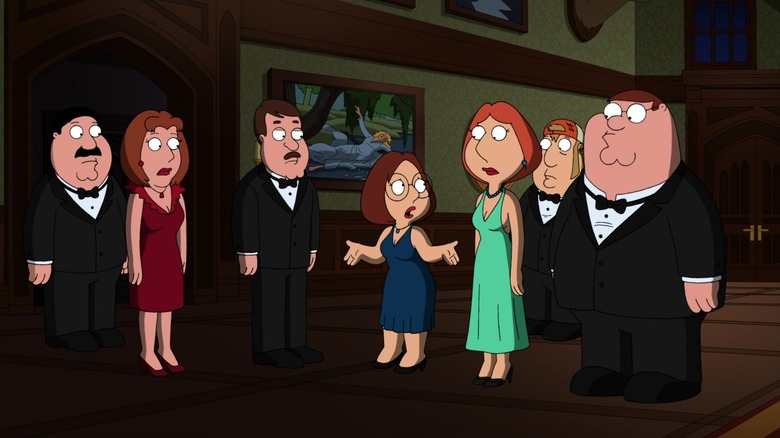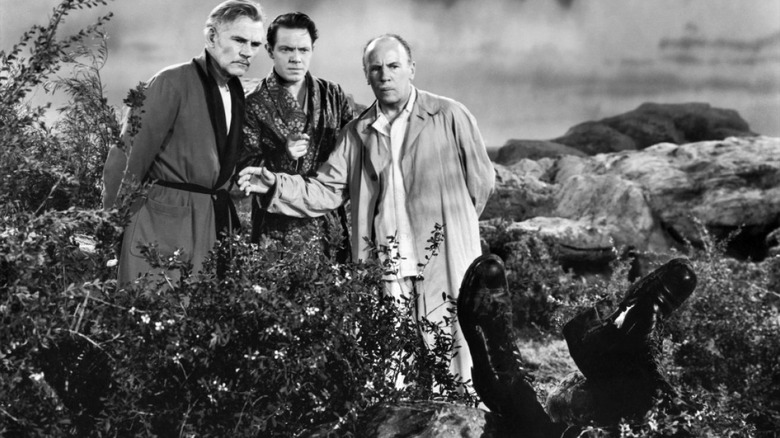Seth MacFarlane's Favorite Family Guy Episode Pays Tribute To A Literary Icon
In the "Family Guy" episode "And Then There Were Fewer" (September 26, 2010), Peter (Seth MacFarlane) and his family — along with most of the citizens of Quahog, Rhode Island — are invited by James Woods (James Woods) to his giant, incredibly remote mansion for a fancy dinner. Woods claims that the dinner is a means to repent for a life of wrongdoing (a claim that would prove prescient) and that he merely wants to extend his many guests a simple act of kindness. But then there is a murder in the shadows. Then Woods himself is murdered by a mysterious figure in a cloak, in plain sight.
Because the mansion is so remote, the Griffins and citizens of Quahog figure that one of them is the murderer. They must race to figure out who it is. In so doing, they discover a blackmail plot and widespread motivations for killing. The murderer takes more lives during the investigation, and tensions mount. One of the murder weapons is James Woods' Golden Globe statuette that he won for his performance in the 1986 TV movie "Promise."
Eventually, it will be revealed that the murderer was ... Ah, I shall not reveal the details here. Needless to say, a well-known "Family Guy" supporting player might have been involved. The episode at large is a proper murder mystery, just peppered with MacFarlane's well-worn, crass, fratboy style of humor.
If the title and story beats of "And Then There Were Fewer" sound familiar, it's because you have read Agatha Christie's 1939 novel "And Then There Were None." That novel, one of the best-known murder mysteries of all time, popularized the premise involving a group of potential victims to a remote location, only to kill them off one and a time, leaving the dwindling survivors to solve the case ... with the murderer potentially among them.
In a 2022 interview with the Hollywood Reporter, MacFarlane admitted that it was one of his favorite episodes.
Seth MacFarlane paid homage to Agatha Christie
"And Then There Were None" was a hit when it was first published, and it has been adapted to film, stage, and TV multiple times since 1939. Luckily, the original title of the novel, which contained a racial slur, was removed pretty early in its life. It was the American publishers that changed the title to "And Then There Were None."
The story saw eight people invited to a mansion on a remote British island. None of them know their hosts, who haven't arrived yet. They play a record in the dining room, and a voice on the record says each one of them has committed a murder. Then someone is poisoned. Then another is murdered in the shadows. Then another. I daren't reveal the murderer's plot, but there's a clever ending that still, after decades, has the capacity to surprise readers.
According to the How Stuff Works website, "And Then There Were None" is one of the highest-selling novels of all time.
It was first adapted to the stage in 1943. The best-known film version of Christie's novel might be René Clair's 1945 adaptation starring Barry Fitzgerald, Walter Huston, and Roland Young. It also was first adapted for BBC radio in 1947 and made its TV debut in 1949. It has been adapted into multiple languages, across various media, and even serves as the inspiration for video games. No writer of murder mysteries is unfamiliar with Christie's work in general and with "And Then There Were None" in particular.
About his "Family Guy" episode, MacFarlane was proud, saying that:
"The Agatha Christie episode is one that sticks out in my mind. That was certainly fun to make."
When Seth MacFarlane wanted to write a murder mystery for "Family Guy" in 2010, it was simply logical that he borrowed the premise and title from Christie's famed work. It felt immutable and natural, and worked even with a crass show like "Family Guy." Plus, it gave him an excuse to gather the many, many "Family Guy" characters in one place.

